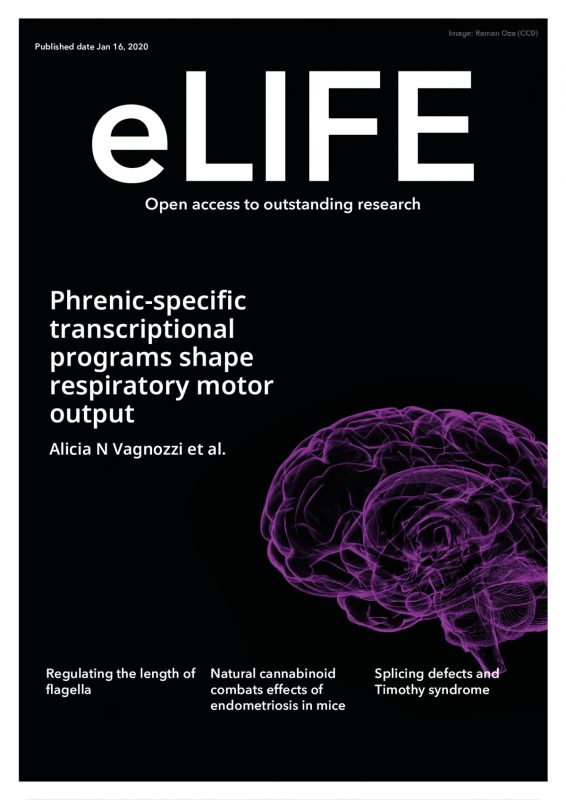Publications
Phrenic-specific transciptional programs shape respiratory motor output
Alicia N Vagnozzi, Kiran Garg, Carola Dewitz, Matthew T Moore, Jared M Cregg, Lucie Jeannotte, Niccolò Zampieri, Lynn T Landmesser, Polyxeni Philippidou
The precise pattern of motor neuron (MN) activation is essential for the execution of motor actions; however, the molecular mechanisms that give rise to specific patterns of MN activity are largely unknown. Phrenic MNs integrate multiple inputs to mediate inspiratory activity during breathing and are constrained to fire in a pattern that drives efficient diaphragm contraction. We show that Hox5 transcription factors shape phrenic MN output by connecting phrenic MNs to inhibitory premotor neurons. Hox5 genes establish phrenic MN organization and dendritic topography through the regulation of phrenic-specific cell adhesion programs. In the absence of Hox5 genes, phrenic MN firing becomes asynchronous and erratic due to loss of phrenic MN inhibition. Strikingly, mice lacking Hox5 genes in MNs exhibit abnormal respiratory behavior throughout their lifetime. Our findings support a model where MN-intrinsic transcriptional programs shape the pattern of motor output by orchestrating distinct aspects of MN connectivity.

All Publications
- Vagnozzi AN, Garg K, Dewitz C, Moore MT, Cregg JM, Jeannotte L, Zampieri N, Landmesser LT, Philippidou P (2020). Phrenic-specific transcriptional programs shape respiratory motor output. eLife e52859.
- https://doi.org/10.7554/eLife.52859
- Edmond M, Hanley O, Philippidou P (2017). Topoisomerase IIβ selectively regulates motor neuron identity and peripheral connectivity through Hox/Pbx-dependent transcriptional programs. eNeuro 4(6).
- https://doi.org/10.1523/ENEURO.0404-17.2017
- Cregg J, Chu K, Hager LE, Maggard RS, Stoltz DR, Eastman B, Alilain WJ, Philippidou P, Landmesser LT, Silver J (2017). A latent propriospinal network can restore diaphragm function after high cervical spinal cord injury. Cell Reports 21(3), 654-665.
- https://doi.org/10.1016/j.celrep.2017.09.076
- Landry-Truchon K, Houde N, Boucherat O, Joncas FH, Dasen JS, Philippidou P, Mansfield JH, Jeannotte L (2017). HOXA5 plays tissue-specific roles in the developing respiratory system. Development 144(19), 3547-3561.
- https://doi.org/10.1242/dev.152686
- Hanley O, Zewdu R, Cohen LJ, Jung H, Lacombe J, Philippidou P, Lee DH, Selleri L, Dasen JS (2016). Parallel Pbx-Dependent Pathways Govern the Coalescence and Fate of Motor Columns. Neuron 91(5), 1005–1020.
- https://doi.org/10.1016/j.neuron.2016.07.043
- Philippidou P, Dasen JS (2015). Sensory-motor circuits: Hox genes get in touch. Neuron 88(3), 437-440 (Preview article).
- https://doi.org/10.1016/j.neuron.2015.10.035
- Philippidou P, Dasen JS (2013). Hox genes: choreographers in neural development, architects of circuit organization. Neuron 80(1), 12-34 (Review article).
- https://doi.org/10.1016/j.neuron.2013.09.020
- Boucherat O, Montaron S, Bérubé-Simard FA, Aubin J, Philippidou P, Wellik DM, Dasen JS, Jeannotte L (2013). Partial functional redundancy between Hoxa5 and Hoxb5 paralog genes during lung morphogenesis. Am J Physiol Lung Cell Mol Physiol. 304(12), L817-30.
- https://doi.org/10.1152/ajplung.00006.2013
- Lacombe J, Hanley O, Jung H, Philippidou P, Surmeli G, Grinstein J, Dasen JS (2013). Genetic and functional modularity of Hox activities in the specification of limb-innervating motor neurons. PLoS Genet. 9(1), e1003184.
- https://doi.org/10.1152/ajplung.00006.2013
- Philippidou P, Walsh CM, Aubin J, Jeannotte L, Dasen JS (2012). Sustained Hox5 gene activity is required for respiratory motor neuron development. Nat Neurosci. 12, 1636-44. (Cover image) Reviewed in Castellani V, Kania A (2012) Breathless without Hox. Nat Neurosci. 12, 1607-1609.
- https://doi.org/10.1038/nn.3242
- Harrington AW, St Hillaire C, Zweifel LS, Glebova NO, Philippidou P, Halegoua S, Ginty DD (2011). Recruitment of actin modifiers to TrkA endosomes governs retrograde NGF signaling and survival. Cell 146(3), 421-34.
- https://doi.org/10.1016/j.cell.2011.07.008
- Philippidou P, Valdez G, Akmentin W, Bowers WJ, Federoff HJ, Halegoua S (2011). Trk Retrograde Signaling Requires Persistent, Pincher-directed Endosomes. Proc Natl Acad Sci U S A 108(2), 852-7.
- https://doi.org/10.1073/pnas.1015981108
- Schecterson LC, Hudson MP, Ko M, Philippidou P, Akmentin W, Wiley J, Rosenblum E, Chao MV, Halegoua S, Bothwell M (2010). Trk activation in the secretory pathway promotes Golgi fragmentation. Mol Cell Neurosci. 43(4), 403-13.
- https://doi.org/10.1016/j.mcn.2010.01.007
- Valdez G*, Philippidou P*, Rosenbaum J, Akmentin W, Shao Y, Halegoua S (2007). Trk-signaling endosomes are generated by Rac-dependent macroendocytosis. Proc Natl Acad Sci U S A 104(30), 12270-5. *equal contribution
- https://doi.org/10.1073/pnas.0702819104
- Boykevisch S, Zhao C, Sondermann H, Philippidou P, Halegoua S, Kuriyan J, Bar-Sagi D (2006). Regulation of ras signaling dynamics by Sos-mediated positive feedback. Curr Biol. 16(21), 2173-9.
- https://doi.org/10.1016/j.cub.2006.09.033
- Valdez G, Akmentin W, Philippidou P, Kuruvilla R, Ginty DD, Halegoua S (2005). Pincher-mediated macroendocytosis underlies retrograde signaling by neurotrophin receptors. J Neurosci. 25(21), 5236-47.
- https://doi.org/10.1523/jneurosci.5104-04.2005
